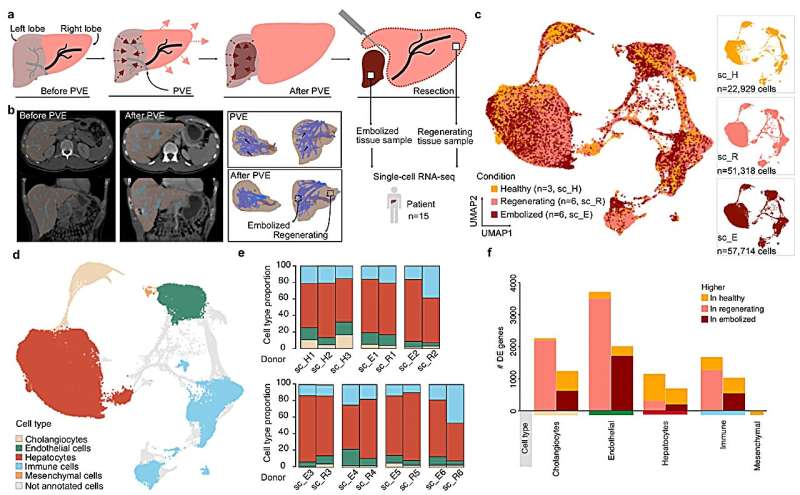This article has been reviewed according to Science X's editorial process and policies. Editors have highlighted the following attributes while ensuring the content's credibility:
fact-checked
peer-reviewed publication
trusted source
proofread
Researchers create a cell atlas of the regenerating liver

The liver has a remarkable ability to regenerate. This property is crucial for maintaining organ function and recovery after injury or surgery. Scientists from the University of Leipzig Medical Center, the Max Planck Institute for Evolutionary Anthropology, TU Dresden and ETH Zurich have used clinical samples to investigate how cell types in the liver change before and after regeneration. They have created a cell atlas from recent study data and published their research in Nature Communications.
In clinical practice, liver regeneration is triggered by an established procedure called portal vein embolization (PVE). It is used in particular in patients with liver tumors or other diseases of the organ to improve the remaining liver function after surgical removal of parts of the tissue.
This procedure involves blocking the portal vein, which transports blood to certain segments of the liver. This causes the blood to flow more strongly through other segments of the organ. The result is enlargement of the well-circulated liver segments and shrinkage of the blocked segments.
At the University of Leipzig Medical Center, in special cases of liver surgery, the regeneration of a liver lobe is initiated before a surgical intervention by means of portal vein embolization using radiological technology. In the current study, tissue samples were taken from patients after PVE. Approximately 21,000 cells and 9,400 cell nuclei were analyzed.
"By identifying cell types using advanced analytical methods, we have been able to create a cell atlas of the healthy human liver. Our research makes a valuable contribution to the field of hepatology in order to better understand human diseases such as fibrosis, cirrhosis and the development of liver cancer," says Dr. Georg Damm, corresponding author of the paper and head of a research laboratory for visceral, transplantation, thoracic and vascular surgery at the University of Leipzig Medical Center.
The cell atlas is a collection of maps that arrange the cell types of a tissue according to the differences in their active genes. Comparing the maps of regenerating and healthy liver tissue shows an upregulation of genes associated with developmental processes, cellular adhesion and inflammation in the liver. The researchers also found that the architecture of the smallest structural units of liver tissue, consisting of liver epithelial cells, is altered from the portal vein to the central vein—this process is crucial for the metabolic functions of the liver.
Changes in the composition of cell subtypes of vascular and immune cells were also observed, suggesting a complex and dynamic adaptation of liver tissue. Analysis of the communication between different liver cell types in this research shows that connective tissue cells form a hub for the interaction between immune and vascular cells, and highlights the importance of intercellular proteins in the regeneration of the human liver.
"Capturing the dynamic changes that occur in this regeneration model opens up new possibilities for future therapeutic interventions. The new data provide a rich source for studying cellular and histological changes in human liver regeneration.
"In follow-up studies, we want to shed more light on individual mechanisms and further validate them in human models," says Professor Daniel Seehofer, Professor of Hepatobiliary and Transplant Surgery at Leipzig University and Head of the Department of Visceral, Transplant, Thoracic and Vascular Surgery at the University of Leipzig Medical Center.
More information: Agnieska Brazovskaja et al, Cell atlas of the regenerating human liver after portal vein embolization, Nature Communications (2024). DOI: 10.1038/s41467-024-49236-7
Journal information: Nature Communications
Provided by Leipzig University



















